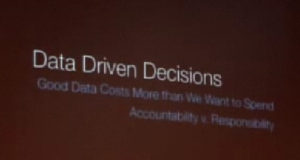The Data Analytics Bandwagon
0 comment
As more and more funders demand real data on how well promised goals are actually being met, how much social impact is actually being achieved, nonprofits better get over their fears and some portion of the public good, all our work is, therefore, good. It isn’t; and we are doing our clients a huge disservice if we don’t take the time to understand what works, doesn’t work and how we might make what doesn’t work better and protect what does work, while even there working to make it even better.
A recent study by IBM’s Corporate Citizenship and Corporate Affairs division and its Institute for Business Value, reveals just how far nonprofits still have to go when it comes to using data. Based on surveys from 330 varied (by mission and operating budget nonprofits) in 34 countries and interviews with an unknown number of senior leaders of nonprofits, IBM’s report, “Leap before you lag, concluded that the vast majority of nonprofits have a long data road ahead of them. Breaking down what is called the “analytics journey” into six segments, 67% of nonprofits are in the dark ages when it comes to using data. More than one-third (37%) use data in an ad hoc manner, meaning that the collection and analysis of data is done only when necessary; it is not a part of everyday activities, not woven into the fabric of how the organization operates. Another 17% use historical data to explain what happened in the past, and another 13% use historical data to look for trends that should influence decision-making. The last three stages of the analytics journey is where nonprofits have moved beyond just assessing impact and gaining clues to making predictions and using data to inform decision making and future designs; just one-third are operating in this predictive mode, with only 5% using analytics to their current max.
Not one of the 5%? No biggie; most nonprofits won’t get there, and it is not my goal to push nonprofits to do so. It is, however, my goal to get folks to understand what they are missing by not getting on the analytics train. For as long as I have been an evaluator, I have told boards that one of the greatest gifts that they can give staff is to require: a) well-designed impact evaluations for each and every program and b) that data be used to drive decision making at both the staff and board levels. This IBM study found that 76% of respondents reported that the pressure to use data and analytics to assess impact came from within the organization; at a close second and third, respectively, was competitive pressure and pressure from funders. The demand is there, the capacity not so much.
Two thirds of the leaders put themselves in the starting block or just beginning down the road of the analytics journey—using data on an ad hoc basis or only to explain what has already happened. But almost four-fifths (78%) of those operating at the higher end of the analytics continuum—those who are using data to look toward the future—report “higher effectiveness in performing their missions,” compared to only 44% of those at the starting gate. No surprise, 67% of the high end folks report improved staff productivity compared to only 24% of those at the opposite end, while 56% of those at the high end report “operating efficiencies” compared to 33% at the other end. How much more endorsement does someone need to get on this data analytics bandwagon?
I recognize that it is not that simple: you cannot say, “We want to be analytics driven,” and, poof! you are there. It will come as no surprise to any executive director longing to become more data driven in their operations and decision making that the number one impediment to achieving that goal is the absence of money (cited by 74% of respondents). Folks pointed to restrictive dollars from grants that don’t include money for evaluation (something that happened regularly in the 1970s and early 1980s) and too many internal needs competing for the limited unrestricted dollars. The second and third most frequently cited impediments are directly and indirectly related to money, as well: having the needed technology (48%) and necessary talent (41%). In last place (21%) was cultural resistance—and that is great progress.
All of this puts back to the proverbial place of being between a rock and a hard space. How do we do what needs to be done to be successful and sustainable—in this case, data analytics—while making sure we don’t upset donors by spending “too much” on overhead?
The opinions expressed in Nonprofit University Blog are those of writer and do not necessarily reflect the opinion of La Salle University or any other institution or individual.

